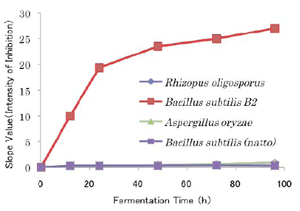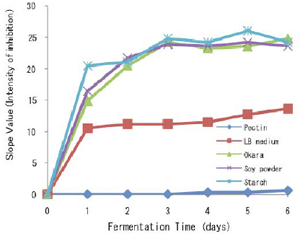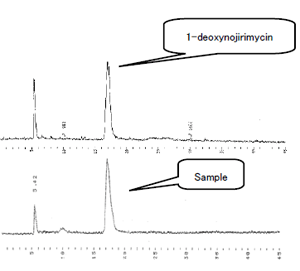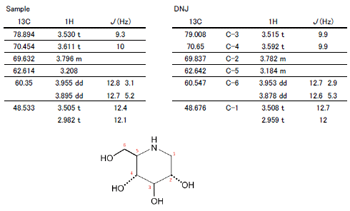Bacillus subtilis B2 derived from “Fermented Okara (a Chinese traditional food)” produce 1-deoxynojirimycin (an inhibitory compound on intestinal glucosidase).
Description
Bacillus subtilis B2 derived from the Chinese traditional fermented okara exhibits a special activity which strongly inhibits α-glucosidase, the key enzyme in raising blood glucose level in metabolic materials. The main component has been identified as 1-deoxynojirimycin (DNJ), which is an imino sugar. Demands of health functionality for foods and farm products are increasing with the rise of interest in health concerns, not only in advanced nations but also in developing countries. Research and development on a food’s health function is one of the effective methods for value addition. On the other hand, in many developing countries such as China, different nations are living under various climates and unique traditional food products develop in these countries. There is the thought that " medicines and foods come from the same source" in China, and from ancient times, it is well known there that a good meal is a way of keeping one’s good health. Therefore, the existence of strong health functionality and newly discovered health functions are highly anticipated. Reducing the rise of blood glucose levels using the Chinese traditional fermented food Okara was analyzed in the early stage of diabetes in this study. In the research, we confirmed that the Chinese traditional fermented food Okara has a strong α-glucosidase inhibitory activity.
The Bacillus subtilis (Bacillus subtilis B2) from the Okara produced an inhibitory activity of α-glucosidase in the culture supernatant (Fig.1). The Bacillus subtilis grew well even in soy flour and starch aside from Okara. And strong α-glucosidase inhibitory activity was shown in the medium which included the soybean component. Significantly, the α-glucosidase inhibitory activity became greatest at around 10% of ethanol fraction by liner gradient of 5 – 30 % ethanol on active charcoal column chromatography (Fig. 2).
Furthermore, this active fraction was fractionated by cation exchange chromatography (CM - Sepharose) and the inhibitory activity fraction was greatest at about pH 3.7. The active component was identified as 1-deoxynojirimycin (DNJ) from the result of the HPLC (TSKgel amide-80, CH3CN:H2O) analysis of the standard compound (Fig.3). Also, as a result of the mass spectrometry performed on this active fraction, the molecular ion peak of molecular weight 164 was detected and the active compound identified as DNJ from the NMR data (Fig. 4). From the above results, the α-glucosidase inhibitor produced by B. subtilis B2 was positively identified as DNJ. The Bacillus subtilis B2 derived from this Chinese traditional food is a type of bacterium that grows well on even a standard medium or starch only, and it is assumed that the action which reduces the activity of α-glucosidase is produced at the same time. The bacterium can be applied to other fermented foods and the development of anti-diabetic foods using the bacterium is being looked forward to.
Figure, table
-
Fig 1α-Glucosidase inhibitory activity of culture fluid.
Various edible bacteria were cultured in Okara culture fluid and the reduction activity of the centrifugal supernatant was measured. -
Fig.2. Changes of the α-glucosidase inhibitory activity in various culture media. -
Fig.3. HPLC Analysis. -
Fig.4. Nuclear Magnetic Reasonance (NMR) Analysis (Sample, Standard DNJ)
- Affiliation
-
Japan International Research Center for Agricultural Sciences Post-harvest Science and Technology Division
- Classification
-
Technical A
- Term of research
-
FY2008(FY2006~2011)
- Responsible researcher
-
YAMAKI Kohji ( National Food Research Institute )
ZHU Yunping ( China Agricultral University )
YOSHIHASHI Tadashi ( Post-harvest Science and Technology Division )
LI Lite ( China Agricultral University )
Kameyama Mayumi ( National Food Research Institute )
KAKEN Researcher No.: 80353994 - ほか
- Publication, etc.
-
Yun-Ping Zhu, Li-Jun Yin, Yong-Qiang Cheng, Kohji Yamaki, Yutaka Mori, Yi-Cheng Su, Li-Te Li (2008) Effects of Sources of Carbon and Nitrogen on Production of α-glucosidase Inhibitor by a Newly Isolated Strain of Bacillus Subtilis B2. Food Chemistry 109, 734-742.
Yun-Ping Zhu, Tadashi Yoshihashi, Yutaka Mori, Lite Li, Mayumi Ohnishi-Kameyama, Kohji Yamaki (2008) Comparison of the characterization of Chinese traditionally fermented okara using various microorganisms. 96th Japanese Society for Food Hygiene and Safety proceedings, p130.
- Japanese PDF
-
2008_seikajouhou_A4_ja_Part21.pdf627.34 KB




